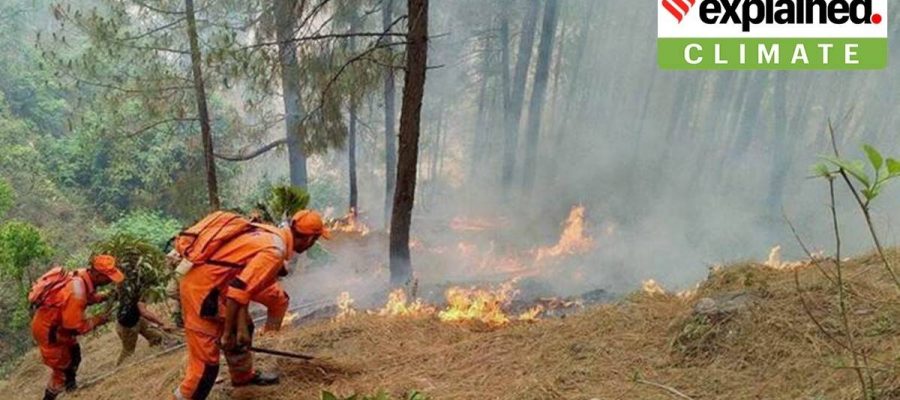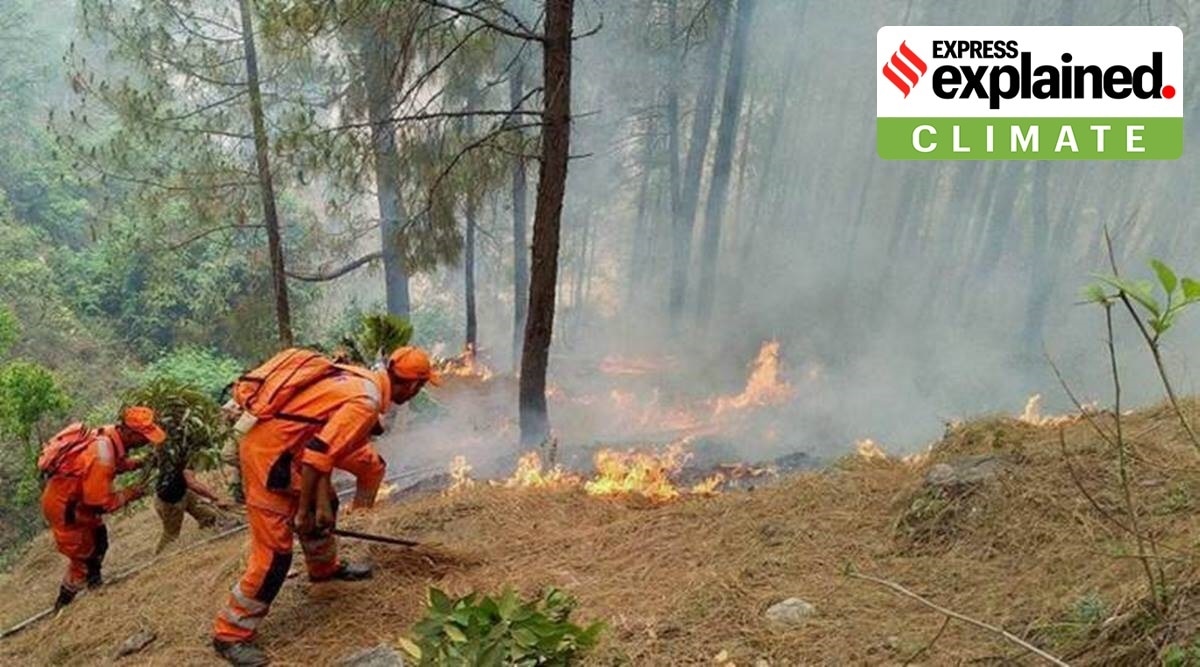Except for periods of precipitation in monsoon and winter, the forests remain vulnerable to wildfires.They cause an estimated loss of several crore rupees each year.
Himachal Pradesh frequently witnesses forest fires during dry weather conditions. This month, a forest fire which started near Kullu raged for several days before being brought under control. Forest fires were also reported in Shimla and other parts of the state.
What is the forest cover of Himachal Pradesh?
Although two-thirds of the total geographical area of Himachal Pradesh is legally classified as forest area, much of this area is permanently under snow, glaciers, cold desert or alpine meadows and is above the tree line. This leaves an effective forest cover of around 28 percent of the total area which amounts to 15,434 square kilometres, as per the Forest Survey of India. Chir Pine, Deodar, Oak, Kail, Fir and Spruce are some of the common trees found here.
How fire prone are these forests?
Except for periods of precipitation in monsoon and winter, the forests remain vulnerable to wildfires. Forest fires are a recurrent annual phenomenon in the state, and most commonly occur in Chir Pine forests.
In the summer season, forest fires occur frequently in the low and middle hills of the state, where forests of Chir Pine are common. The dry summer season from March to June coincides with the shedding of highly-combustible needles by Chir Pine trees. Once the fallen dry needles catch fire, it can spread quickly over the entire forest due to the action of the wind. However, due to their thick bark, the Chir Pine trees are themselves relatively unharmed by these fires, and can spring back to life during the monsoon season.
During the post-monsoon season and in winters, forest fires are also reported in higher areas, including parts of Shimla, Kullu, Chamba, Kangra and Mandi districts, where they usually occur in grasslands.
What causes the fire?
Natural causes such as lightning or rubbing of dry bamboos with each other can sometimes result in fires, but forest officials maintain that almost all forest fires can be attributed to human factors.
When the grass is dry, even a small spark, such as someone dropping a burning matchstick, torchwood or a bidi/cigarette, can cause a massive fire. A spark can also be produced when dry pine needles or leaves fall on an electric pole.
People who frequently pass through a forest to gather minor produce, take their animals for grazing or for other purposes may set up a temporary hearth to cook food or warm themselves. If they leave behind a smouldering fire, it can develop into a forest fire. Also, when people burn their fields to clear them of stubble, dry grass or undergrowth, the fire sometimes spreads to the adjoining forest.
What are the fuels of such massive fires?
The dry leaf litter on the forest ground acts as a ready fuel. Fallen tree leaves, dry grass, weeds, low brushwood, deadwood on the forest floor, logs and stumps etc form the surface fuels. Below the loose litter, decaying materials such as humus, wood, shrubs, roots, much and peat can also support the combustion. Above the surface level, dry standing trees, mosses, lichens, dry epiphytic or parasitic plants, and fallen branches trapped in the understorey can spread the fire to the upper foliage and the tree crowns.
How much damage do the forest fires cause?
Forest fires can cause a lot of damage to the regeneration in the forests and their productivity. Moisture-loving trees such as Oaks and Deodars may give way to other species and exotic weeds. Forests help maintain aquifers and continuous flow of streams and springs, and provide firewood, fodder and non-timber produce to the local communities – all these capacities may get adversely affected in case of a fire.
Forest fires may destroy organic matter in the soil and expose the top layer to erosion. They may also impact the wildlife by burning eggs, killing young animals and driving the adult animals away from their safe haven. Sometimes, a forest fire may get out of control and extend to human settlements, thus posing danger to human life and property.
According to the Himachal forest department, forest fires cause an estimated loss of several crore rupees each year. From 2016-17 to 2019-20, the annual loss to the state due to forest fires has ranged from Rs 1.7 crore to Rs 3.5 crore. Around 1,200 to 2,500 forest fires were reported each year during this period affecting thousands of hectares.
Are the recent forest fires unusual?
Forest fires are common every time a dry spell hits the state. Himachal witnessed unusually dry weather conditions last year from August to November, resulting in drought-like conditions. That period also saw a large number of forest fires – at least 500 fires were recorded from August till early November. Currently, the weather has been dry for the past week, resulting in some fires.
What is done to prevent and control forest fires?
Forecasting fire-prone days using meteorological data, clearing camping sites of dried biomass, early burning of dry litter on the forest floor, growing strips of fire-hardy plant species within the forest, and creating fire lines in the forests are some of the methods to prevent fires (fire lines are strips in the forest kept clear of vegetation to prevent the fire from spreading). Once a fire starts, early detection and quick action by fire-fighting squads is crucial.
For such activities, the state forest department has a fire protection and fire control unit. In 1999, the state government notified forest fire rules which restrict or regulate certain activities in and around forest areas such as lighting a fire, burning agricultural stubble or undergrowth (ghasnis) and stacking inflammable forest produce such as dried leaves and firewood.
Source: Read Full Article


